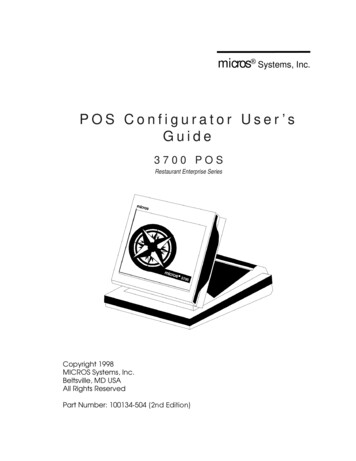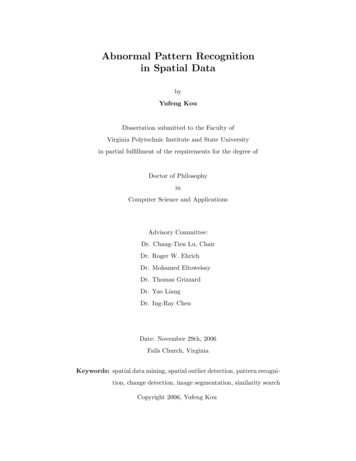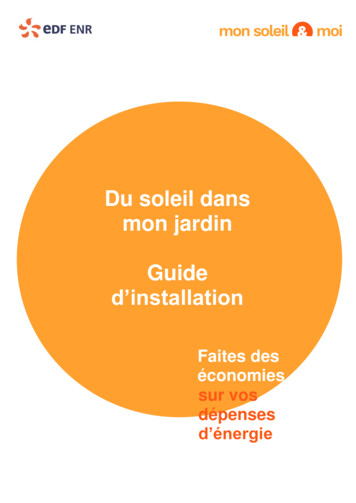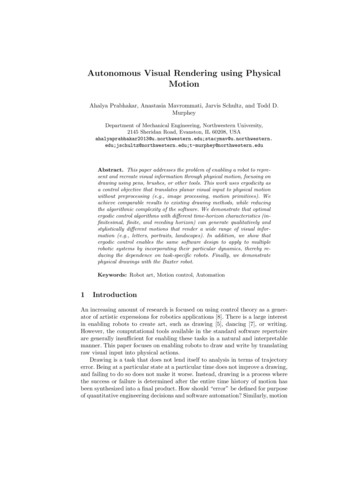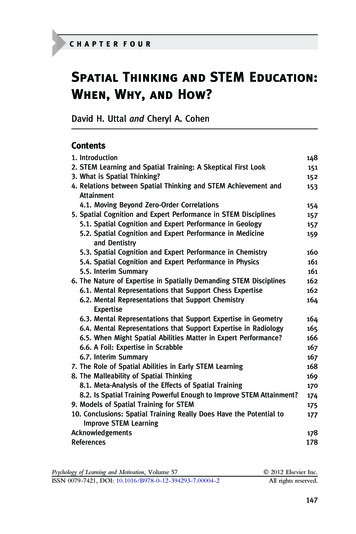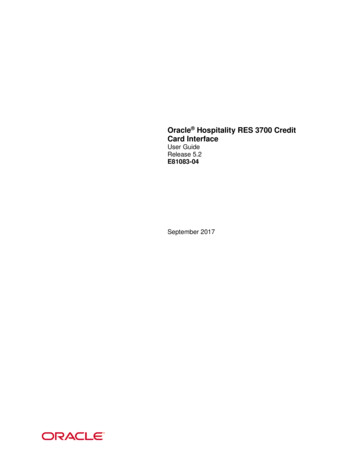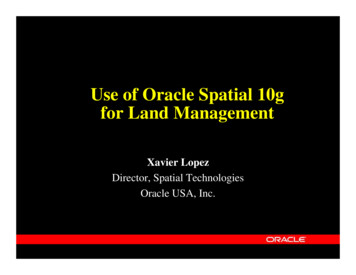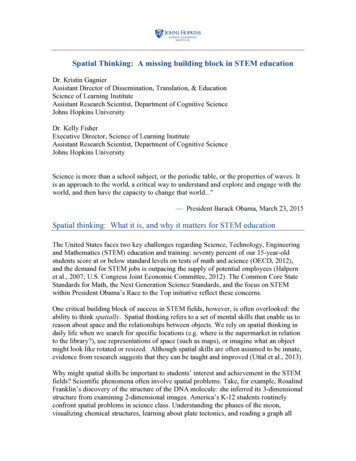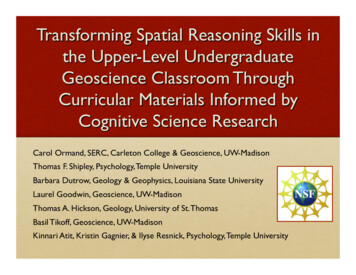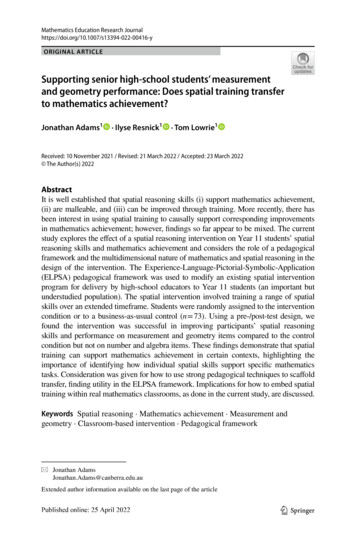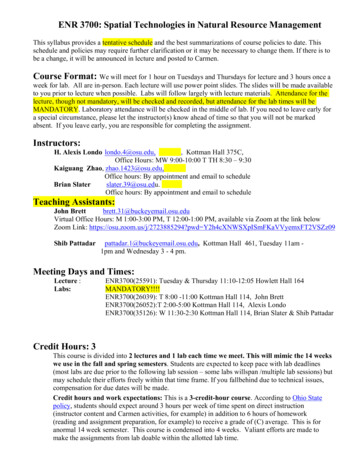
Transcription
ENR 3700: Spatial Technologies in Natural Resource ManagementThis syllabus provides a tentative schedule and the best summarizations of course policies to date. Thisschedule and policies may require further clarification or it may be necessary to change them. If there is tobe a change, it will be announced in lecture and posted to Carmen.Course Format: We will meet for 1 hour on Tuesdays and Thursdays for lecture and 3 hours once aweek for lab. All are in-person. Each lecture will use power point slides. The slides will be made availableto you prior to lecture when possible. Labs will follow largely with lecture materials. Attendance for thelecture, though not mandatory, will be checked and recorded, but attendance for the lab times will beMANDATORY. Laboratory attendance will be checked in the middle of lab. If you need to leave early fora special circumstance, please let the instructor(s) know ahead of time so that you will not be markedabsent. If you leave early, you are responsible for completing the assignment.Instructors:H. Alexis Londo londo.4@osu.edu,, Kottman Hall 375C,Office Hours: MW 9:00-10:00 T TH 8:30 – 9:30Kaiguang Zhao, zhao.1423@osu.edu,Office hours: By appointment and email to scheduleslater.39@osu.edu.Brian SlaterOffice hours: By appointment and email to scheduleTeaching Assistants:John Brettbrett.31@buckeyemail.osu.eduVirtual Office Hours: M 1:00-3:00 PM, T 12:00-1:00 PM, available via Zoom at the link belowZoom Link: https://osu.zoom.us/j/2723885294?pwd Y2h4cXNWSXpISmFKaVVyemxFT2VSZz09Shib Pattadarpattadar.1@buckeyemail.osu.edu, Kottman Hall 461, Tuesday 11am 1pm and Wednesday 3 - 4 pm.Meeting Days and Times:Lecture :Labs:ENR3700(25591): Tuesday & Thursday 11:10-12:05 Howlett Hall 164MANDATORY!!!!ENR3700(26039): T 8:00 -11:00 Kottman Hall 114, John BrettENR3700(26052):T 2:00-5:00 Kottman Hall 114, Alexis LondoENR3700(35126): W 11:30-2:30 Kottman Hall 114, Brian Slater & Shib PattadarCredit Hours: 3This course is divided into 2 lectures and 1 lab each time we meet. This will mimic the 14 weekswe use in the fall and spring semesters. Students are expected to keep pace with lab deadlines(most labs are due prior to the following lab session – some labs willspan /multiple lab sessions) butmay schedule their efforts freely within that time frame. If you fallbehind due to technical issues,compensation for due dates will be made.Credit hours and work expectations: This is a 3-credit-hour course. According to Ohio Statepolicy, students should expect around 3 hours per week of time spent on direct instruction(instructor content and Carmen activities, for example) in addition to 6 hours of homework(reading and assignment preparation, for example) to receive a grade of (C) average. This is foranormal 14 week semester. This course is condensed into 4 weeks. Valiant efforts are made tomake the assignments from lab doable within the allotted lab time.
Prerequisites: NoneExclusions: Not open to students with credit for ENR 3750.Textbooks/Readings: No textbooks are required for this course.There will be a few assignedreadings.Optional Texbooks/Readings:GIS Fundamentals: A First Text on Geographic Information SystemsAuthor: Paul BolstadPublisher: Eider Press; 4th Edition (2012) ISBN-13: 978-0971764736Remote Sensing and Image InterpretationAuthors: Thomas Lillesand, Ralph W. Kief, JonathanChapmanPublisher: Wiley; 6th edition (2007)ISBN-13: 978-0470052457Additional Required Materials: You will need a computer with adequate storage for thecourse material. We will discuss the downloading of the software necessary to complete this course on thefirst lectureday. All the software necessary for this class is free. Links will be provided on the Carmen pagefor you to safely and securely download the software.Other Fees or Requirements:NoneCourse Description:Introduction to methods of collecting and utilizing spatial information (GIS, RS and GPS) for EnvironmentalandNatural Resources management. This introductory course in spatial information for natural resources andenvironment presents the basic concepts and vocabulary of spatial information systems and geospatialtechnologies, particularly in the context of environmental management. During this course, we will examinespatial information systems, remote sensing and aerial imagery, GPS systems for spatial location, spatialmodelingand methods for assessment of temporal change in natural and managed ecosystems. Students willlearn how to access use a variety of spatial data including map data, digital aerial photography and highresolution satellite imagery in conjunction with geographic information systems (GIS), digital elevationmodels (DEMs), and GlobalPositioning Systems (GPS) to solve problems in the natural resources.There will be a basic introduction to traditional paper-based maps and aerial photos. However, theemphasis is on computer based interpretation, measurement, and analysis of digital vertical imagery, andintegration with other spatial data. The central goal is to teach students how to use a wide range of data inGIS software, as would be expected, for many jobs (private and public) in natural resources management.Basic geographic and cartographic principles such as resolution, distortion, and map scale will be introduced.Students will learn to make professional quality maps for presentations and reports using GeographicInformation Systems. An introduction to basic non-digital interpretation techniques using paper aerialphotographs will be provided. We will learn techniques to capture and analyze information from digitalimagery for use in modern GIS software.An introduction to the wide range of problems in the natural andenvironmental resources where spatial data areuseful will be discussed. Applications of spatial information ina variety of natural resource management scenarios including agriculture, forestry, wildlife, wetlands andaquatic systems, urban and other highly disturbed systems will be introduced, Students will learn how toidentify a wide range of natural and anthropogenic features in aerialimagery and to make basic measurementsfor natural resources inventory and land use change.
The basic skills needed to use air photos, multi-band satellite imagery, and digital elevation modelswithingeographic information systems (QGIS, Google Earth, ArcGIS) will be practiced. Students will beintroduced topublic sources for free digital vertical imagery to use in this class and future work.Goals:Students will gain an understanding of the principles, theories, and methods used in geospatial information(GIS), remote sensing (RS) and global positioning systems (GPS). Students will be introduced to thecriteria forand practice of spatial data acquisition, organization and applications (including GIS, RS, andGPS), the implications of readily available spatial information and the potential of science and technologyto address problems of the contemporary world.Learning Outcomes:Students will gain an understanding of the principles, theories, and methods used in geospatial information(GIS),remote sensing (RS) and global positioning systems (GPS). Students will be introduced to the criteriafor and practice of spatial data acquisition, organization and applications (including GIS, RS, and GPS), theimplicationsof readily available spatial information and the potential of science and technology to addressproblems of the contemporary world.Expected Learning Outcomes:1. Students will develop a basic understanding of the nature and representation of geographic data; specifically,students understand the basic facts, principles, theories and methods of spatial information management as relatedto GIS, RS andGPS technologies.2. Students explore examples of the interdependence of scientific and technological developments and managementof theEarth’s resources.3. Students will learn interpretation and measurement techniques used to create extract, and manipulate informationfromvarious data types inherent to GIS, RS and GPS technologies.4. Students discuss social and philosophical implications of scientific discoveries and understand the potential ofscienceand technology to address problems of the contemporary world, particularly environmental issues, foodsecurity, and human health.Specific Learning Outcomes:1. Students understand the nature of spatial information of the environment2. Students explore various technologies for data acquisition and organization3. Students learn about important spatial information forms and representations4. Students examine the role of spatial information and systems in understanding and managing natural resources5. Students learn about methods for assessing environmental changeLearning goals and objectives will be satisfied through a sequence of lectures,computerlab exercises and demonstrations, and online presentations,Topic/Day OutcomesDate(s)Week 1Week 2Week 3Week 4Week 5 - EXAMWeek 6Week 7,8,9Topic(s)Introduction to QGIS – Lab –Google EarthData Types, Projections – Lab –Campus MapOperations, Map making – lab –accessing public DataSpatial Data , Location – Lab –Habitat SuitabilityIntroduction to Remote Sensing–Lab – Statistics from GISGPS – Lab – GPS and GISEMR – Lab – NDVI
Week10Week 11,12 EXAM WK 10Week 13,14Week 15Spatial Orientation andGeoreferencing – Lab –GeoreferencingClassification – Lab – SolvingSpatial QuestionsPhoto Interpretation andapplications –Lab (TBD)Lidar, GIS ApplicationsCourse technologyFor help with your password, university e-mail, Carmen, or any other technology issues, questions, orrequests,contact the OSU IT Service Desk. Standard support hours are available at OCIO Help Hours, andsupport for urgent issues is available 24x7. Self-Service and Chat support: (http://ocio.osu.edu/selfservice)Phone: 614-688-HELP (4357)Email: 8help@osu.eduTDD: 614-688-8743Baseline technical skills for online courses Basic computer skills such as file structure, file types, and common functions such as copying,pasting,downloading, saving etc. will be needed. Additionally, web-browsing skills will also benecessary.Navigating Carmen: for questions about specific functionality, see the Canvas Student Guide.Technology skills necessary for this specific course Zoom text, audio, and video chatRecording a slide presentation with audio narrationRecording, editing, and uploading videoRequired equipment Computer: current Mac (OS X) or PC (Windows 7 ) with high-speed internet connectionWebcam: built-in or external webcam, fully installed and testedMicrophone: built-in laptop or tablet mic or external microphoneRequired software Microsoft Office 365: All Ohio State students are now eligible for free Microsoft Office 365ProPlus through Microsoft’s Student Advantage program. Full instructions for downloading andinstallation isfound https://ocio.osu.edu/kb04733.Approved browsers:QGISAnydeskTeamviewerZoom
Carmen AccessYou will need to use BuckeyePass multi-factor authentication to access your courses in Carmen. To ensurethatyou are able to connect to Carmen at all times, it is recommended that you take the following steps: Register multiple devices in case something happens to your primary device. Visit theBuckeyePass -Adding a Device help article for step-by-step instructions. Request passcodes to keep as a backup authentication option. When you see the Duo loginscreen on your computer, click “Enter a Passcode” and then click the “Text me new codes”button that appears.This will text you ten passcodes good for 365 days that can each be usedonce. Download the Duo Mobile application to all of your registered devices for the ability to generateone-time codes in the event that you lose cell, data, or Wi-Fi service.If none of these options will meet the needs of your situation, you can contact the IT Service Desk at 614688-4357 (HELP) and the IT support staff will work out a solution with you.Course Schedule:Each lecture will be given using PPT slides and made available to the students. Each lab will begin with a5 – 15 min PPT slide presentation. After the introductions, detailed instructions, data to be used, answersheets forthe student to use will available on CARMEN for the student to download and extract. I will beavailable during the entire lab period to help the students execute the procedures as written. If the studentneeds additional time, they can contact me.WeekTopicsAgendaDeliverables1&2Introduction to QGIS –Lab – Google Earth3Data Types, Projections –Lab – Campus MapStudent will be given directions ondownloading software. Instructionswill be given to navigate topredetermined locations, performassigned tasks and answer a 50question worksheet.Student will be given detailedinstructions for downloading,extracting, and displaying data inQGIS. The outcome is a map.4GIS Operations, Mapmaking – lab – accessingpublic DataStudent will become morefamiliar with spatial data.This is an assignment to buildtalking points for lecture. Theanswers to the questions aregrade out of 100 points.The students are expected tocreate a synopsis of the stepsthey have executed as per ourinstructions. They are todetermine and list the inputsand the outputs of severalsteps. This is in an effort toenforce the outcomes of thedetailed steps we haveprovided. In addition, there isone map due. Bothdeliverables are graded out ofa total of 230 pointsThe students are expected tocreate a synopsis of the stepsthey have executed as per ourinstructions. In addition,there are two maps due.Deliverables are graded out ofa total of 300 points.Students will be given detailedinstructions to download NLCD,NAIP imagery, and politicalboundaries from multiple websites.The student manipulates DEM data(given) to produce 2 to maps.
5&6Spatial Data , LocationLab – Habitat SuitabilityEXAM Sept 23, 2021The students are given the ecologicalrequirements for an endangeredspecies. In addition, instructions aregiven as to how to synthesize spatialdata down to specific locationswhere the plant might occur or towhere restoration for this plant islikely to be successful7Introduction to RemoteSensing– Lab – Statisticsfrom GISUsing the data from the above lab,we arrive at the answer from a rasterand a vector solution. Statistics suchas area and average elevation arethen calculated.9Tentative GPS - lab – GPSand GIS10EMR – Lab – NDVI11Introduction to RemoteSensing– Lab – Statisticsfrom GISThe students will use point data overLake Erie of the suspended sedimentconcentrations (SSC) as measured ona particular. Using the point data andremote sensing data, a linearrelationship is developed and SSC ispredicted for the entire lake.Using satellite imagery, the studentsare given instructions to createspectral signatures, a NDVI layer,and to execute an unsupervisedclassification for a small area onLake Erie shores.The students are given an areawithout spatial reference and create aspatially referenced image. Oncecompleted, the students are asked tocreate several vector layers usingheads up digitizing.The students will be given specificscenarios and expected to come upwith a data flow and procedural mapto obtain the answer. We will do 3 inclass together and they will then beassigned 1 to do on their own.Final ProjectsEXAM Nov. 2, 202112Classification – Lab –Solving Spatial Questions13,14,and 15Interpretation, Lidar, GISApplications –LabThe students are asked tocreate a synopsis for each filethey are asked to create. Theyare asked for what files areused to produce the resultinglayer, what algorithm wasexecuted, and how did theyoutput change from the inputs(in appearance andinformation). In addition,there is one map due.Deliverables are graded out ofa total of 400 points.The students are asked foractual numerical answersderived from the output, givenanother way to arrive at theabove output and asked tocompare and contrast the twomethods. This is graded outof 200 points.There are 2 questions and amap that are due for this lab.It is graded out of 200 points.The students are asked tocomplete a classification andturn in a map of the completedclassifications. It is gradedout of 250 points.The students are required toturn in a map from theirgeoreferencing with the roadnetwork on top as well as theirvector layers displayed It isgraded out of 200 points.From the last scenario, thestudents are expected to turnin a flow chart with inputs,procedures, and expectedoutputs. It is graded out of300 points.
Assignment due dates and details will be posted in Carmen.Instructor’s policy on late or make up work:Assignments are due at the beginning of class or lab period. Late assignments will result in a 10%reductionin possible points from which to start the grading for each day the assignment is late. You must have emailconsentfrom the instructor to turn in assignments late without penalty. This must be dated before theassignment is due. Late assignments will only be accepted up to 7 days after the date for which theassignment was originally due.If you will be unable to take an exam, arrangements to make up an exam must be made by email at least 3days prior to the exam and be documented by email confirmation. If you miss an exam and have not madearrangements before the exam period you will not be able to make up the missed exam except in extremecircumstances and with the approval of the professor.TestingAll exams are open book open note exams and will be given online. THEY WILL BE OPEN ONLYDURING THE ASSIGNED LECTURE TIME (11:10 – 12:05 the day of the exam). If you have SLDSaccommodations, those will be honored.Evaluation:TaskWeekly LaboratoryEach mid-term (date, TBA)Percentage ofGrade:Final Exam (Cumulative)TOTAL50%13%24%100%Assignment details can be found in Carmen.5LAB ASSIGNMENTS:You will submit all the required assignments through Carmen. They will be evaluated using a rubric.Grades and feedback will be available generally before the next lab is due.EXAMS:Both midterms and final exam are open note open book but must be completed without any external helpor communication. The exam date for the midterms are September 23, 2021 and November 2, 2021. Theywill be given during class. The FINAL exam will be given during the time assigned per the university’scalendar. There WILL BE A FINAL EXAM. Look at the University Final Schedule. Check it here formore details: tent/AU21Finals.pdfMidterms and exams consist of fill in the blank (a word bank with the answers as well as some additionalwords will be provided), short answer questions such as specific definitions, and 2 to 3 discussionquestions. The midterm is designed to take 55 minutes while the final is designed to be 1 hour and 45minutes.
Grading Scale: The standard grading scale is 77-79.9GradeAAB BBC Percentage73-76.970-72.967-69.960-66.9 60GradeCCD DECOURSE POLICIESFaculty feedback and response timeWe are providing the following list to give you an idea of our intended availability throughout thecourse.(Remember that you can call 614-688-HELP at any time if you have a technical problem.) Grading and feedback: For Each lab assignment you should receive feedback by the nextclassperiod, but no later than 2 class periods.E-mail: We will reply to e-mails within generally within 24 hours, but for urgentquestions, please text Dr. Londo 614-495-6738 between the hours of 7:00 am and 10:00pm. Most questions are computer related and will require me to use teamviewer or anydeskto access your screen. From here we will be able to answer your question and get you goingagain.Attendance Policy:You are required to be present for lab. This is an intense course and sitting still for 5 hours a day whileusing acomputer screen can be difficult. Lectures will be recorded and posted to Carmen. Labs will NOTbe recordedand you are required to attend lab unless you have notified me prior to lab. Unexcused lababsences will result in a 25% reduction in the lab assignment. Office hours and live sessions: LABS ARE THE ONLY MADATORY ATTENDANCE.SEE ABOVEAll lectures and office hours, are optional. For lectures, I will provide a recording that you canwatchlater.E-Mail Etiquette: Include a descriptive statement in the subject line.Use proper salutations when beginning an e-mail.Be concise in the body of the e-mail, use complete sentences and proper grammar.Use an appropriate closure at the end of each e-mail followed by your first and last name.If replying to an e-mail, reference the original e-mail and its content.Be selective of your choice of words. Emotions are difficult to convey in text and withoutthebenefit of facial expressions your sentiment can be lost in the words you choose to write.
DON’T Use all capital letters; this conveys a tone of ANGER. Use e-mail as a format to criticize other individuals. Ask for your grade via e-mail. Grades will not be discussed by e-mail. If you need todiscuss agraded item make an appointment with me. E-mail to inquire when grades will be posted. We will work toward submitting gradespromptly,however, recognize that grading assignments and exams requires considerabletime to ensure uniformity and fairness. Send an e-mail out of frustration or anger. Learn to save the e-mail as a draft and review at alatertime when emotions are not directing the content.TEXT Etiquette: Include your name, OS you are using, and the assignment you are working on. Be concise. And try NOT to let auto-text corrections mislead your message.For example GPS is auto corrected to GOD. Sometimes this will slip by, just correct insubsequentmessage.Quizzes and exams:You must complete the midterm and final exam yourself, without any external help orcommunication.Midterms and exam will be given using Proctorio.Written assignments:There will be a series of lab assignments due for this class. The format for these will be given in class.Please have a journal article from your profession to use as reference for how you will format tables,figures, and literature cited.Reusing past work:In general, you are prohibited in university courses from turning in work from a past class to yourcurrentclass, even if you modify it. If you want to build on past research or revisit a topic you'veexplored in previous courses, please discuss the situation with me.Falsifying research or results:All research you will conduct in this course is intended to be a learning experience; you should neverfeeltempted to make your results or your library research look more successful than it was.UNIVERSITY POLICIES see: urces forcurrentversionsAcademic Misconduct: It is the responsibility of the Committee on Academic Misconduct toinvestigate or establish procedures for the investigation of all reported cases of studentacademic misconduct. The term "academic misconduct" includes all forms of studentacademic misconduct wherever committed; illustrated by, but not limited to, cases ofplagiarism and dishonest practicesin connection with examinations. Instructors shall report allinstances of alleged academic misconduct to the committee (Faculty Rule 3335-5-487). Foradditional information, see the Codeof Student Conduct at Student Lifehttp://studentconduct.osu.edu.Ohio State’s academic integrity policyAcademic integrity is essential to maintaining an environment that fosters excellence in teaching,research, and other educational and scholarly activities. Thus, The Ohio State Universityand theCommittee on Academic Misconduct (COAM) expect that all students have read andunderstandthe University’s Code of Student Conduct, and that all students will complete allacademic and scholarly assignments with fairness and honesty. Students must recognize thatfailure to follow
the rules and guidelines established in the University’s Code of Student Conduct and thissyllabusmay constitute “Academic Misconduct.”The Ohio State University’s Code of Student Conduct (Section 3335-23-04) defines academicmisconduct as: “Any activity that tends to compromise the academic integrity of theUniversity, or subvert the educational process.” Examples of academic misconduct include(but are not limited to) plagiarism, collusion (unauthorized collaboration), copying the workof another student, and possession of unauthorized materials during an examination.Ignorance of the University’s Code of Student Conduct is never considered an “excuse” foracademic misconduct,so I recommend that you review the Code of Student Conduct and,specifically, the sections dealing with academic misconduct.If I suspect that a student has committed academic misconduct in this course, I amobligated byUniversity Rules to report my suspicions to the Committee on AcademicMisconduct. If COAM determines that you have violated the University’s Code of StudentConduct (i.e., committed academic misconduct), the sanctions for the misconduct couldinclude a failing gradein this course and suspension or dismissal from the University.If you have any questions about the above policy or what constitutes academic misconduct inthiscourse, please contact me.Other sources of information on academic misconduct (integrity) to which you can refer include: The Committee on Academic Misconduct web pages (COAM Home) Ten Suggestions for Preserving Academic Integrity (Ten Suggestions) Eight Cardinal Rules of Academic Integrity (www.northwestern.edu/uacc/8cards.htm)Copyright disclaimerThe materials used in connection with this course may be subject to copyright protection andare only for the use of students officially enrolled in the course for the educational purposesassociatedwith the course. Copyright law must be considered before copying, retaining, ordisseminating materials outside of the course.Intellectual Property (covered by copyright) includes Course materials (Text, Audio, Video,Multimedia, Sims, Apps, etc.), and Student Generated materialsDisability ServicesThe University strives to make all learning experiences as accessible as possible. If youanticipate or experience academic barriers based on your disability (including mental health,chronic or temporarymedical conditions), please let me know immediately so that we canprivately discuss options. To establish reasonable accommodations, I may request that youregister with Student Life Disability Services. After registration, make arrangements with me assoon as possible to discuss your accommodations so that they may be implemented in a timelyfashion. SLDS contactinformation: slds@osu.edu; 614-292-3307; slds.osu.edu; 098 Baker Hall, 113 W. 12th Avenue.Diversity:The Ohio State University affirms the importance and value of diversity in the student body. Ourprograms and curricula reflect our multicultural society and global economy and seek to provideopportunities for students to learn more about persons who are different from them. We arecommittedto maintaining a community that recognizes and values the inherent worth and dignityof every person;fosters sensitivity, understanding, and mutual respect among each member of ourcommunity; and encourages each individual to strive to reach his or her own potential.Discrimination against any individual based upon protected status, which is defined as age, color,disability, gender identity or expression, national origin, race, religion, sex, sexual orientation, orveteran status, is prohibited.
Requesting accommodationsIf you would like to request academic accommodations based on the impact of a disability qualifiedunder the Americans with Disabilities Act and Section 504 of the Rehabilitation Act of 1973,contact your instructor privately as soon as possible to discuss your specific needs. Discussions areconfidential.In addition to contacting the instructor, please contact the Student Life DisabilityServices at 614-292- 3307 or ods@osu.edu to register for services and/or to coordinate anyaccommodations you might need in your courses at The Ohio State University.Go to Office of Student Life - Disability Services for more information.UNIVERSITY RESOURCESCounseling and Consultation Services:As a student you may experience a range of issues that can cause barriers to learning, such asstrained relationships, increased anxiety, alcohol/drug problems, feeling down, difficultyconcentrating and/or lack of motivation. These mental health concerns or stressful eventsmay lead to diminished academic performance or reduce a student’s ability to participate indaily activities. The Ohio State University offers services to assist you with addressing theseand otherconcerns you may be experiencing. If you or someone you know are suffering fromany of the aforementioned conditions, you can learn more about the broad range ofconfidential mental health services available on campus via the Office of Student Life’sCounseling and ConsultationService (CCS) by visiting ccs.osu.edu or calling 614-292-5766.CCS is located on the 4th Floor of the Younkin Success Center and 10th Floor of LincolnTower. You can reach an on call counselor when CCS is closed at 614-292-5766 and 24hour emergency help is also available through the 24/7 National Suicide Prevention Hotlineat 1-800-273-TALK orat suicidepreventionlifeline.org.Title IX:Title IX makes it clear that violence and harassment based on sex and gender are CivilRightsoffenses subject to the same kinds of accountability and the same kinds of supportapplied to offenses against other protected categories (e.g., race). If you or someone youknow has beensexually harassed or assaulted, you may find the appropriate resources attitleix.osu.edu or bycontacting the Ohio State Title IX Coordinator, Kellie Brennan, attitleix@osu.edu.Grievances:According to University Policies, if you have a problem with this class, you should seek toresolve the grievance concerning a grade or academic practice by speaking first with theinstructor or professor. Then, if necessary, take your case to the department chairperson,college dean or associate dean, and t
ENR 3700: Spatial Technologies in Natural Resource Management . GIS Fundamentals: A First Text on Geographic Information Systems Author: Paul Bolstad Publisher: Eider Press; 4th Edition (2012) ISBN-13: 978-0971764736 . security, and human health. Specific Learning Outcomes: 1. Students understand the nature of spatial information of the .
